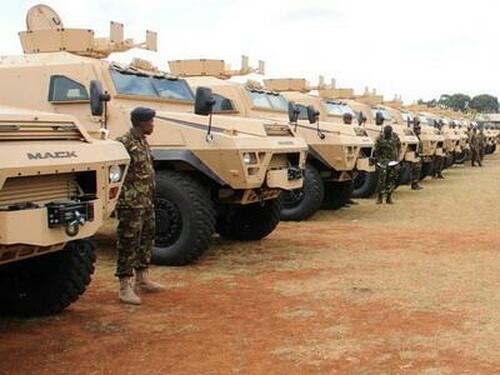
Authored by Kyle Anzalone via The Libertarian Institute,
Hundreds of Kenyan soldiers deployed to Haiti have begun patrolling the streets around key government installations. Gunfire was heard during the operation and an American armored vehicle broke down.
This week, Kenyan soldiers in American MRAP vehicles patrolled the streets of Port au Prince near the National Palace. The troops are in Haiti on a UN Security Council-endorsed mission to take control of the capital city from armed groups.
In recent years, gangs have seized, from the government, a growing portion of Port au Prince. The situation worsened after the US-backed Ariel Henry’s ascension to power following the assassination of President Jovenel Moise in 2021. Henry recently agreed to hand over control of Haiti at the White House’s urging. Gangs currently control 80% of Port au Prince.
For the Kenyan soldiers, the first patrols in Port au Prince were not uneventful. Scores of gunshots were reported, and Haitian journalist Windy Phele posted a video on X showing one of the armored vehicles getting towed.
After months of delays, hundreds of Kenyan soldiers arrived in Haiti during recent weeks. The Kenyan operations in Haiti – dubbed a policing mission – are supported and funded by the US.
The new US-backed government in Haiti, led by Prime Minister Garry Conille, issued a series of decrees empowering the Kenyan soldiers to target the armed Haitian groups.
Un des véhicules blindés d’infanterie Maxx Pro, livré par les USA à Haïti pour la MMSS, utilisé pour la première fois par les soldats kényans dans le cadre d’un exercice, est tombé en panne en pleine opération ce mercredi dans la capitale haïtienne. pic.twitter.com/GgroJHVtqv
— Windy Phele (@windyphele) July 17, 2024
This "will allow the government to have the necessary tools and instruments to act, confront the bandits and restore the authority of the state."
He added, "The final objective is to take back all the areas that are controlled by the gangs, house by house, neighborhood by neighborhood, and city by city."
Authored by Kyle Anzalone via The Libertarian Institute,
Hundreds of Kenyan soldiers deployed to Haiti have begun patrolling the streets around key government installations. Gunfire was heard during the operation and an American armored vehicle broke down.
This week, Kenyan soldiers in American MRAP vehicles patrolled the streets of Port au Prince near the National Palace. The troops are in Haiti on a UN Security Council-endorsed mission to take control of the capital city from armed groups.
In recent years, gangs have seized, from the government, a growing portion of Port au Prince. The situation worsened after the US-backed Ariel Henry’s ascension to power following the assassination of President Jovenel Moise in 2021. Henry recently agreed to hand over control of Haiti at the White House’s urging. Gangs currently control 80% of Port au Prince.
For the Kenyan soldiers, the first patrols in Port au Prince were not uneventful. Scores of gunshots were reported, and Haitian journalist Windy Phele posted a video on X showing one of the armored vehicles getting towed.
After months of delays, hundreds of Kenyan soldiers arrived in Haiti during recent weeks. The Kenyan operations in Haiti – dubbed a policing mission – are supported and funded by the US.
The new US-backed government in Haiti, led by Prime Minister Garry Conille, issued a series of decrees empowering the Kenyan soldiers to target the armed Haitian groups.
Un des véhicules blindés d’infanterie Maxx Pro, livré par les USA à Haïti pour la MMSS, utilisé pour la première fois par les soldats kényans dans le cadre d’un exercice, est tombé en panne en pleine opération ce mercredi dans la capitale haïtienne. pic.twitter.com/GgroJHVtqv
— Windy Phele (@windyphele) July 17, 2024
This “will allow the government to have the necessary tools and instruments to act, confront the bandits and restore the authority of the state.”
He added, “The final objective is to take back all the areas that are controlled by the gangs, house by house, neighborhood by neighborhood, and city by city.”
Loading…





